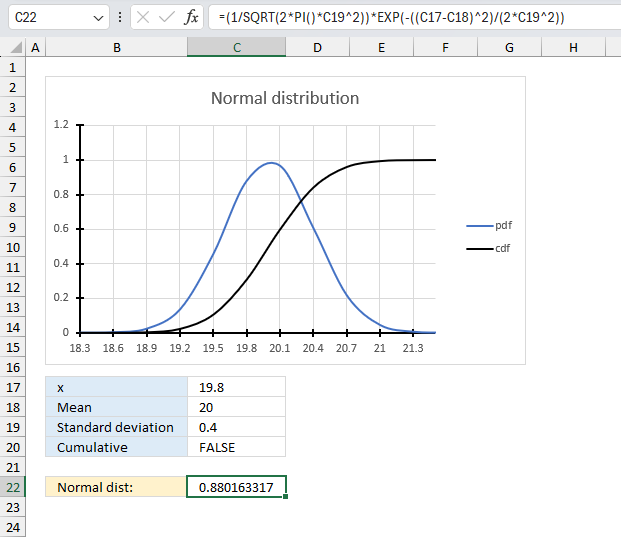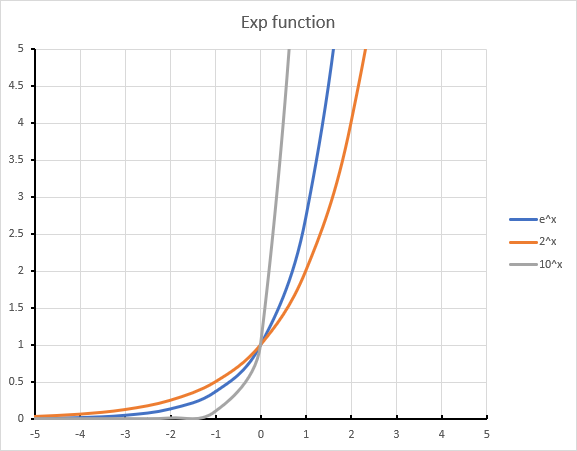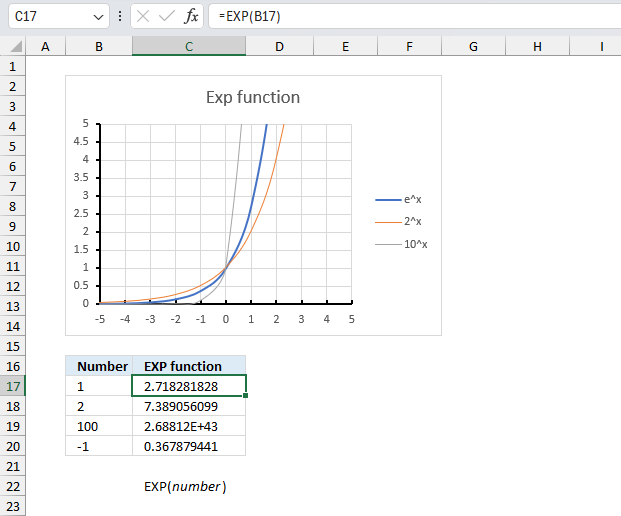How to use the EXP function

What is the EXP function?
The EXP function returns e raised to the power of a given number.
Table of Contents
1. Introduction
What is e?
It is the base of the natural logarithm, ln.

The chart above shows the curve of ex, 2x, and 10x
What is the definition of e?
e is defined to be the limit of (1 + 1/n) raised to the nth power as n approaches infinity.
In equation form: e = lim (1 + 1/n)n as n -> infinity
The limit of this exponential growth pattern is the unique number e. For example:
(1 + 1/1)1 = 2
(1 + 1/2)2 = 2.25
(1 + 1/3)3 = 2.37037
The limit of this exponential growth pattern is the unique number e.
e = e1 equals approx. 2.71828182845904.
e2 equals approx. 7.389056099
What is the EXP function in Excel an abbreviation of?
The "EXP" name refers to Exponent or Exponential.
What is ln?
ln is the natural logarithm and e is it's base.
eln x = x
ln ex = x
What are the key exponential rules?
- Product of Powers
e^x * e^y = e^(x+y)
When two numbers with exponents are multiplied together, and the bases are the same, you add the exponents.
Example, e5 * e10 = e(5+10) - Quotient of Powers
e^x / e^y = e^(x-y)
Two numbers with exponents are divided and the bases are the same you subtract the exponents.
Example, e10 / e5 = e(10-5) - Power of Powers
(e^x)^y = e^(x*y)
If a base is raised to a power and the entire expression is further raised to another power then the two powers are multiplied, and the base remains unchanged.
Example, (e10)5 = e(10*5) - Power of Product
(ey)^x = e^x * y^x
When a product expression within parentheses is raised to an exponent, each element within the product is raised to that exponent individually.
Example, (5*e)10 = e10 * e5 - Negative Exponent
e^-x = 1/e^x
A negative exponent indicates that the base should be taken as the reciprocal and raised to the positive equivalent of the exponent.
Example, e-x = 1/ex - Fractional Exponent
e^(1/x) = x√e
A number raised to a fractional exponent is equivalent to taking the root of that number.
Example, e(1/x) = x√e
What applications has e?
- Logarithms to base e models growth/decay.
- Compound interest - e models exponential growth in finance.
- Probability theory - e features in Poisson distributions.
- Normal distributions - e in its probability density function.
- Euler's identity - e^ix = cos(x) + i*sin(x) links e with trigonometry and the imaginary unit i.
- Bacterial growth - The growth of bacterial populations can be modeled involving e.
- Mathematical constants - e is related to mathematical constants like π, φ and γ via infinite series and limits.
- Calculus - The derivative of e^x is itself e^x.
What logarithmic functions exist in Excel?
| Name | Excel Function | Description |
|---|---|---|
| Natural Logarithm | LOG(x) | Calculates the natural logarithm (base e) of x |
| Natural Logarithm | LN(x) | Same as LOG(x), calculates the natural log of x |
| Common Logarithm | LOG10(x) | Calculates the base 10 logarithm of x |
| Binary Logarithm | LOG2(x) | Calculates the base 2 logarithm of x |
| Exponentiation | POWER(x, y) | Raises x to the power of y |
| Exponential | EXP(x) | Raises e to the power of x |
2. EXP Function Syntax
EXP(number)
| number | Required. The number used as an exponent to e. |
3. EXP Function Example 1

How to calculate the natural exponential function for four different values [1, 2, 100, -1]?
Cell range B17:B20 contains the arguments: 1, 2, 100, -1 respectively.
The formula in cell C17:
- Cell C17 calculates the natural exponential of 1 which is approx. 2.71828182845905.
- Cell C18 calculates the natural exponential of 2 which is approx. 7.38905609893065.
- Cell C19 calculates the natural exponential of 100 which is approx. 2.68811714181614E+43.
- Cell C17 calculates the natural exponential of -1 which is approx. 0.367879441171442.
The chart above shows the curves of
- ex - the blue thicker line. Find values -1, 1, and 2 on the x-axis. From those points, draw imaginary vertical lines upwards until it intersects with the blue curve, which represents the natural exponential function e. Then, follow the points of intersection horizontally towards the y-axis to the left. You will find that the corresponding values on the y-axis is approximately 2.71, 7.38, and 0.37.
- 2x - This curve represents the exponential function with base 2.
- 10x - This curve represents the exponential function with base 10.
The graph displays three exponential curves, the exponential function e^x has a smoother, gradually increasing curve, while 10^x has a much steeper, faster growth rate as x increases. The 2^x curve has a slower growth rate compared to ex and 10x.
4. EXP Function Example 2

In a manufacturing process, the diameter of a particular component follows a normal distribution with a mean of 20 mm and a standard deviation of 0.4 mm. What is the probability density function for a value of 19.8 mm?
The natural number e is used in the math formula for calculating the probability density function of a normal distribution which is a continuous probability distribution that is widely used in statistics and probability theory.

The text representation of this formula is:
f(x | μ, σ^2) = (1 / (2πσ^2)^0.5) * e^(-(x - μ)^2 / (2σ^2))
- x denotes the probability density function of the normal distribution for a given value of x
- μ represents the mean or expected value of the distribution.
- σ^2 (sigma squared) represents the variance of the distribution which is the square of the standard deviation (σ).
The arguments are:
- x = 19.8 mm
- mean = 20 mm
- standard_dev = 0.4
These arguments are specified in cells C17,C18, and C19 respectively, in the image above.
Formula in cell C22:
This formula in cell C22 is built based on the math formula for calculating the probability density function of a normal distribution described above. It returns 0.88016331691075 which can be found on the y-axis in the chart above.
In the image above, locate the value 19.8 on the x-axis. From that point, draw an imaginary vertical line upwards until it intersects with the blue curve, which represents the probability density function. Then, follow the point of intersection horizontally towards the y-axis to the left. You will find that the corresponding value on the y-axis is approximately 0.88.
5. Function not working

The EXP function returns a
- #VALUE! error if the argument is non-numeric.
- #NAME? error if you misspelled the function.
- propagates error if the source data point is an error.
5.1 Troubleshooting the error value

When you encounter an error value in a cell a warning symbol appears, displayed in the image above. Press with mouse on it to see a pop-up menu that lets you get more information about the error.
- The first line describes the error if you press with left mouse button on it.
- The second line opens a pane that explains the error in greater detail.
- The third line takes you to the "Evaluate Formula" tool, a dialog box appears allowing you to examine the formula in greater detail.
- This line lets you ignore the error value meaning the warning icon disappears, however, the error is still in the cell.
- The fifth line lets you edit the formula in the Formula bar.
- The sixth line opens the Excel settings so you can adjust the Error Checking Options.
Here are a few of the most common Excel errors you may encounter.
#NULL error - This error occurs most often if you by mistake use a space character in a formula where it shouldn't be. Excel interprets a space character as an intersection operator. If the ranges don't intersect an #NULL error is returned. The #NULL! error occurs when a formula attempts to calculate the intersection of two ranges that do not actually intersect. This can happen when the wrong range operator is used in the formula, or when the intersection operator (represented by a space character) is used between two ranges that do not overlap. To fix this error double check that the ranges referenced in the formula that use the intersection operator actually have cells in common.
#SPILL error - The #SPILL! error occurs only in version Excel 365 and is caused by a dynamic array being to large, meaning there are cells below and/or to the right that are not empty. This prevents the dynamic array formula expanding into new empty cells.
#DIV/0 error - This error happens if you try to divide a number by 0 (zero) or a value that equates to zero which is not possible mathematically.
#VALUE error - The #VALUE error occurs when a formula has a value that is of the wrong data type. Such as text where a number is expected or when dates are evaluated as text.
#REF error - The #REF error happens when a cell reference is invalid. This can happen if a cell is deleted that is referenced by a formula.
#NAME error - The #NAME error happens if you misspelled a function or a named range.
#NUM error - The #NUM error shows up when you try to use invalid numeric values in formulas, like square root of a negative number.
#N/A error - The #N/A error happens when a value is not available for a formula or found in a given cell range, for example in the VLOOKUP or MATCH functions.
#GETTING_DATA error - The #GETTING_DATA error shows while external sources are loading, this can indicate a delay in fetching the data or that the external source is unavailable right now.
5.2 The formula returns an unexpected value

To understand why a formula returns an unexpected value we need to examine the calculations steps in detail. Luckily, Excel has a tool that is really handy in these situations. Here is how to troubleshoot a formula:
- Select the cell containing the formula you want to examine in detail.
- Go to tab “Formulas” on the ribbon.
- Press with left mouse button on "Evaluate Formula" button. A dialog box appears.
The formula appears in a white field inside the dialog box. Underlined expressions are calculations being processed in the next step. The italicized expression is the most recent result. The buttons at the bottom of the dialog box allows you to evaluate the formula in smaller calculations which you control. - Press with left mouse button on the "Evaluate" button located at the bottom of the dialog box to process the underlined expression.
- Repeat pressing the "Evaluate" button until you have seen all calculations step by step. This allows you to examine the formula in greater detail and hopefully find the culprit.
- Press "Close" button to dismiss the dialog box.

There is also another way to debug formulas using the function key F9. F9 is especially useful if you have a feeling that a specific part of the formula is the issue, this makes it faster than the "Evaluate Formula" tool since you don't need to go through all calculations to find the issue..
- Enter Edit mode: Double-press with left mouse button on the cell or press F2 to enter Edit mode for the formula.
- Select part of the formula: Highlight the specific part of the formula you want to evaluate. You can select and evaluate any part of the formula that could work as a standalone formula.
- Press F9: This will calculate and display the result of just that selected portion.
- Evaluate step-by-step: You can select and evaluate different parts of the formula to see intermediate results.
- Check for errors: This allows you to pinpoint which part of a complex formula may be causing an error.
The image above shows cell reference B17 converted to hard-coded value using the F9 key. The EXP function requires numerical values which is not the case in this example. We have found what is wrong with the formula.
Tips!
- View actual values: Selecting a cell reference and pressing F9 will show the actual values in those cells.
- Exit safely: Press Esc to exit Edit mode without changing the formula. Don't press Enter, as that would replace the formula part with the calculated value.
- Full recalculation: Pressing F9 outside of Edit mode will recalculate all formulas in the workbook.
Remember to be careful not to accidentally overwrite parts of your formula when using F9. Always exit with Esc rather than Enter to preserve the original formula. However, if you make a mistake overwriting the formula it is not the end of the world. You can “undo” the action by pressing keyboard shortcut keys CTRL + z or pressing the “Undo” button
5.3 Other errors
Floating-point arithmetic may give inaccurate results in Excel - Article
Floating-point errors are usually very small, often beyond the 15th decimal place, and in most cases don't affect calculations significantly.
Functions in 'Math and trigonometry' category
The EXP function function is one of 62 functions in the 'Math and trigonometry' category.
How to comment
How to add a formula to your comment
<code>Insert your formula here.</code>
Convert less than and larger than signs
Use html character entities instead of less than and larger than signs.
< becomes < and > becomes >
How to add VBA code to your comment
[vb 1="vbnet" language=","]
Put your VBA code here.
[/vb]
How to add a picture to your comment:
Upload picture to postimage.org or imgur
Paste image link to your comment.
Contact Oscar
You can contact me through this contact form